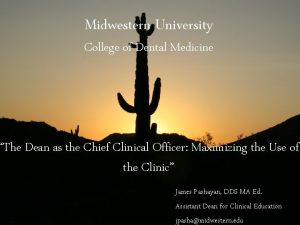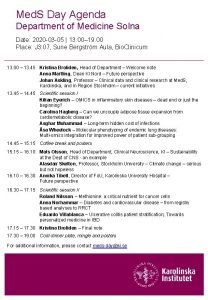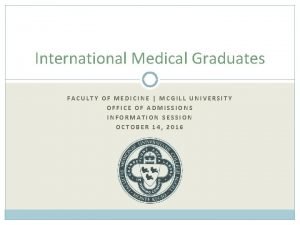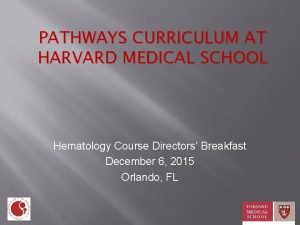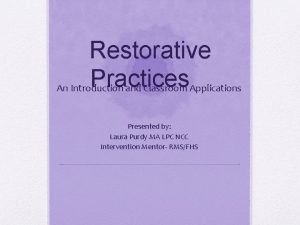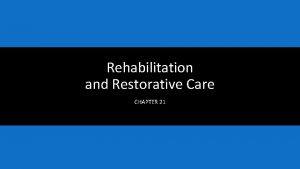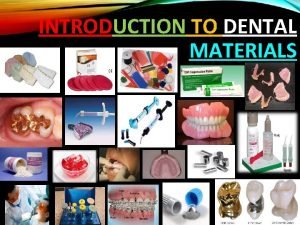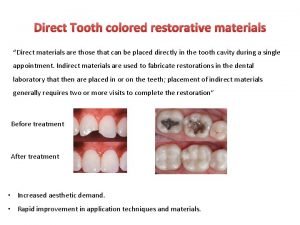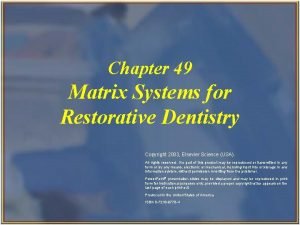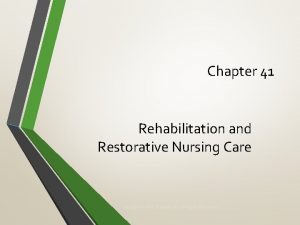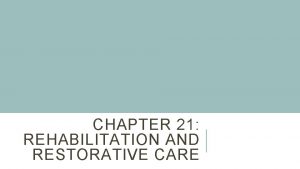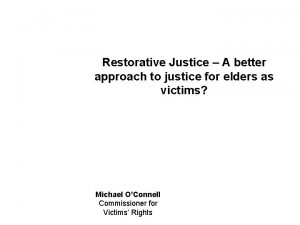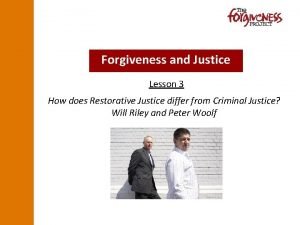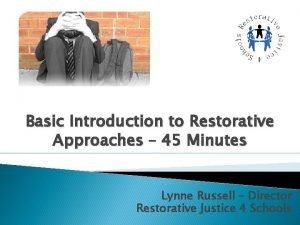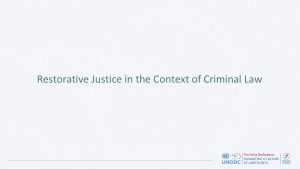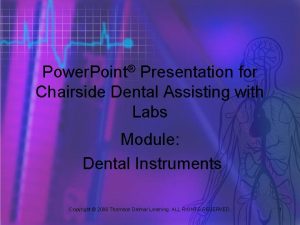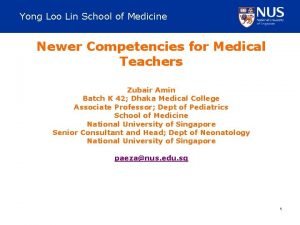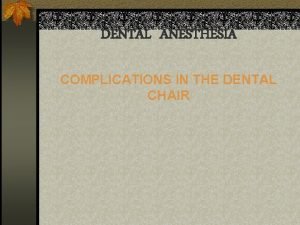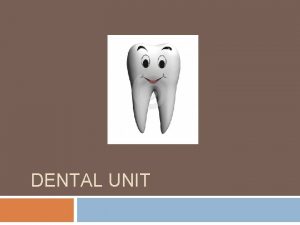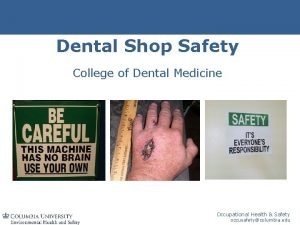Harvard School of Dental Medicine Department of Restorative

















































- Slides: 49

Harvard School of Dental Medicine Department of Restorative Dentistry Predoctoral Curriculum in Dentistry Diagnosis and Prevention Block 2002 Dental Terminology Msd Fábio Tunes

Dental Terminology - Why ?

Maxillary and Mandibular Teeth The portion of the jaw that supports the teeth is called the alveolar process. The bony socket in which the root fits is called the alveolus. Teeth in the upper jaw are called maxillary teeth. In the lower jaw they are called mandibular teeth.

Tooth Eruption The crown portion of the tooth erupts through the bone and alveolar ridge mucosa. The tooth continues to erupt from the bone and surrounding oral mucosa, now called gingiva.

Crown and Root Eruption of a tooth is thus moving of the tooth through its surrounding tissues so that the clinical crown gradually appears longer.

Crown and Root Each tooth has a crown and root portion. The crown is covered with enamel, the root is covered with cementum. Crown and root are joined at the cemento-enamel junction, also called the CEJ. The line that demarcates it is called the cervical line.

Crown and Root The anatomical crown is the whole crown of the tooth that is covered by enamel, whether erupted or not. The clinical crown is only that part seen above the gingiva. Therefore, if the anatomical crown does not fully erupt, the part that is visible is considered the clinical crown, and the unerupted portion is part of the clinical root.


Crown and Root The root portion may be single or multi-rooted with a bifurcation or trifurcation, i. e. , division of the root portion into two or three roots. Each root has one apex, or terminal end. The root portion is held in its position relative to the other teeth in the dental arch by being firmly anchored in the bony alveolar process of each jaw. Trifurcation Alveolar Process A A Bifurcation

Dental Tissues – Enamel – Dentin – Cementum – Pulp

Enamel • • • Most densely mineralized and hardest tissue in the human body. 96% unorganic and 4% organic matter and water. Forms the outer surface of the anatomic crown. Thickest over the tip of the crown, becomes thinner as it approaches the cervical line. Color varies with thickness and mineralization.

Dentin • • Dentin forms the main portion or body of the tooth (crown and root) It is wrapped in an envelope of enamel that covers the crown, and an envelope of cementum that covers the root.

Dentin • • Hard, dense, calcified tissue; softer than enamel but harder than bone or cementum. Chemical composition is 70% inorganic and 30% organic matter and water. Appears yellowish, has elasticity Unlike enamel, dentin is capable of adding to itself (secondary dentin, reparative dentin); dentinforming cells = odontoblasts

Dentin • Secondary Dentin: Is the dentin that continues to be laid down in the pulp chamber after tooth eruption • Reparative Dentin: Is the dentin laid down in response to caries or trauma.

Cementum • • Bone-like substance that covers the root. Main function is to provide a medium for attachment of the tooth to the alveolar bone as part of the periodontium Not as dense or hard as enamel or dentin but is denser than bone to which it bears physiological resemblance. The chemical composition is 45% to 50% inorganic and 50% to 55% organic components.

Cementum • • The union of cementum and dentin is called the dentinocemental junction. 2 types of cementum: A) cellular - confined to the apical 1/3 of root and can reproduce itself. acellular - covers the entire anatomical root. Cementum as dentin continues to be formed after tooth eruption by cementoblasts B) •

Pulp • • The pulp is the nourishing, sensory, and dentin-reparative system of the tooth. Composed of blood vessels, lymph vessels, connective tissues, nerve tissues, and dentin formation cells (odontoblasts)

Pulp • • Pulp is housed in the center of the tooth within the dentin surrounding the pulp tissue. The walls of the pulp cavity are lined with odontoblasts. Their chief function is to lay down primary and secondary dentin.

Pulp • • Anatomically the pulp chamber is divided into two areas: 1) The pulp chamber in the coronal portion of the tooth. 2) The root (pulp) canals in the roots of the tooth. Pulp chamber and root (pulp) canals = pulp cavity.

Types of Teeth • • Anterior Teeth: – Incisors – Canines Posterior Teeth: – Premolars – Molars

Types of Teeth • • • Functions of teeth vary. Tooth shapes and sizes differ with their location in the jaws. The three basic functions of teeth are cutting, holding or grasping, and grinding.

Incisors • Eight incisors total: 2 maxillary centrals (LI) 2 maxillary laterals (CL) 2 mandibular centrals (ci) 2 mandibular laterals (li) • Incisors are designed to cut • Cutting edge = incisal edge LI CI li CI ci ci LI li

Incisors The tongue side, or lingual surface, is shaped like a shovel: • aids in guiding the food into the mouth. • is the major contributor to the anterior guidance of occ. Iusion

Canines • • • 4 canines total: 2 maxillary, 2 mandibular Designed to function as holding or grasping teeth Also used as a tearing tool C Longest teeth in the human dentition C Canine guidance in lateral excursive movements of occlusion C C

Canines • • • Canines are the best anchored and most stable teeth, since they have the longest roots. Canines are shaped triangularly in cross section. This makes it possible for a canine to hold its place in the corner of the mouth. This shape resists both anterior and posterior forces of displacement.

Premolars (or Bicuspids) • • A cross between canines and molars. 8 premolars: 1 st and 2 nd in each tooth quadrant Not as long as canines, and usually have two cusps, rather than one large ridge. Like canines they aid in holding food, and they also help grind rather than incise it (the pointed buccal cusps hold the food while the lingual cusps grind it. )

Molars • • • Larger than premolars Most posterior teeth: 1 st, 2 nd and 3 d molars The function of the 12 molars is to chew or grind up food. They do not have incisal edges, instead they have cusps, which are designed to interlock upper and lower molars. There are 4 or 5 cusps on the occlusal surface of each molar.

Molars Maxillary (upper) and mandibular (lower) molars differ greatly from each other in shape, size, number of cusps, and roots.

Surfaces of Teeth • • • Crowns of the teeth are divided into surfaces named according to the direction in which they face. Anterior teeth have 4 surfaces (m, f, d, l) plus the incisal ridge or edge Posterior teeth have 5 surfaces. The 5 th surface is the occlusal surface

Surfaces of Teeth • • Surfaces facing the tongue = lingual surfaces. Surfaces facing the cheeks = facial surfaces, or labial (lip) surface for anterior teeth, buccal (cheek) surface for posterior teeth

Surfaces of Teeth • • A tooth surface facing that of a neighboring tooth in the same arch (next to each other) is called a proximal surface. Each tooth has two proximal surfaces: mesial and distal. The mesial proximal surface of a tooth is closest to the midline of the face. The distal proximal surfaces away from the midline.

Division of Surfaces For the purpose of facilitating the location of various areas within a specific surface of a tooth, the surface is divided into thirds mesial, middle and distal third - of each the facial and lingual surface.

Division of Surfaces • • • The proximal (mesial and distal) surfaces of a tooth are divided into a facial, a middle, and a lingual third. Surfaces are further divided into sections perpendicular to the above, i. e. any of the proximal, facial, or lingual surfaces are divided into an incisal, a middle, and a cervical third. Posteriorly, the incisal 1/3 is called the occlusal 1/3.

Line Angles The line angle forms the junction between two tooth surfaces; e. g. , the junction of the buccal surface and the occlusal (incisal) surface of a tooth is a line angle.

Line Angles • Line Angles for Anterior Teeth

Line Angles • Line Angles for Posterior Teeth

Point Angles A point angle is the point at which three surfaces meet; e. g. the point at which the mesial, labial and incisal surfaces join is called the mesio-labioincisal point angle

Point Angles • Point Angles for Anterior Teeth

Point Angles • Point Angles for Posterior Teeth

Landmarks • • • The crown portion of teeth develops from 4 or more growth centers or lobes. The lobes grow and eventually fuse leaving but a line or groove on the erupted tooth where fusion of the lobes took place. These shallow grooves or lines that separate the original growth centers are called developmental grooves.

Landmarks • • • Incisors, canines and most premolars are developed from 4 lobes, 3 facial and 1 lingual. 1 st molars are developed from 5 lobes: the upper from 2 facial and 3 lingual, the lower from 2 lingual and 3 facial lobes. 2 nd molars are developed from 4 lobes, 2 facial and 2 lingual.

Landmarks • • • Anterior teeth show 2 developmental grooves on their labial surfaces. These 2 grooves separate the 3 lobes that formed the labial surface. The fourth developmental lobe of anterior teeth is located at the lingual surface of the crown. This fourth lobe is called the cingulum, and it makes up the bulk of the cervical third of the lingual surface of an anterior tooth.

Landmarks • • A concavity is a carved-out section or area -> Fossa The opposite of a concavity is a convexity, a bulging out area of the tooth crown - > Ridge, Cusp (no cusp on incisors!)

Landmarks • • A fossa (plural fossae) is a depression or concavity, on an area of the tooth crown. A tubercle is a small elevation of enamel on some portion of the crown of a tooth. Fossae

Landmarks • • • Anterior teeth have a lingual fossa between the marginal ridges and incisal to the cingulum. A pinpoint hole within the fossa, is called a pit. Pits are named after their location on a tooth; e. g. a lingual pit occurs on the lingual surface of a tooth. C

Landmarks • • • A cusp is a mound on the crown portion of the tooth that makes up a major division of its occlusal or incisal surface. Cusps are found on premolars, molars and canines, not on incisors. Cusp are name after their location (MB, DB, ML, DL) Buccal Disto-Buccal C C Mesial Disto-Lingual Mesio-Buccal C C Lingual Mesio-Lingual

Landmarks • Marginal ridges are the rounded borders of enamel that form the mesial and distal shoulders of the occlusal surfaces of posterior teeth and the mesial and distal shoulders of the lingual surface of the anterior teeth.

Landmarks Triangular ridges (TR) are the main ridges on each cusp that run from the cusp tip to the central part of the occlusal surface, i. e. the central, mesial, distal grooves and pits MR = Marginal ridge MR TR TR TR MR TR

Landmarks A transverse ridge is the union of a buccal and a lingual triangular ridge that cross the occlusal surface of a posterior tooth.
 Restorative dentistry instruments
Restorative dentistry instruments San francisco unified school district restorative practices
San francisco unified school district restorative practices Midwestern university college of dental medicine
Midwestern university college of dental medicine Department of medicine solna
Department of medicine solna Faculty of medicine mcgill
Faculty of medicine mcgill Harvard class schedule
Harvard class schedule Harvard study abroad
Harvard study abroad Michael luca harvard business school
Michael luca harvard business school Harvard business review for educators
Harvard business review for educators Harvard medical school curriculum
Harvard medical school curriculum Restorative circle questions
Restorative circle questions Social discipline window
Social discipline window Restorative language
Restorative language 21 rehabilitation and restorative care
21 rehabilitation and restorative care Principles of restorative justice
Principles of restorative justice Ideal dental material
Ideal dental material Restorative justice in schools powerpoint
Restorative justice in schools powerpoint Restorative practice circle questions
Restorative practice circle questions Tooth colored restorative materials
Tooth colored restorative materials Spot welded band
Spot welded band Chapter 41 rehabilitation and restorative nursing care
Chapter 41 rehabilitation and restorative nursing care Chapter 21 rehabilitation and restorative care
Chapter 21 rehabilitation and restorative care Chapter 21 rehabilitation and restorative care
Chapter 21 rehabilitation and restorative care Ali hearn restorative practices
Ali hearn restorative practices Restorative conversation script
Restorative conversation script Restorative care definition
Restorative care definition Anita wadhwa
Anita wadhwa Social justice and community action
Social justice and community action San diego restorative justice
San diego restorative justice Punitive vs restorative discipline
Punitive vs restorative discipline Sfusd restorative practices
Sfusd restorative practices Restorative justice hubs chicago
Restorative justice hubs chicago Pros and cons of restorative justice
Pros and cons of restorative justice Sycamore tree victim awareness programme
Sycamore tree victim awareness programme Restorative mini cf
Restorative mini cf Peter woolf and will riley
Peter woolf and will riley Restorative justice script
Restorative justice script Equilibrium restorative balance
Equilibrium restorative balance Pbis and restorative practices
Pbis and restorative practices Restorative care versus rehabilitation
Restorative care versus rehabilitation What is restorative justice
What is restorative justice Restorative practice
Restorative practice Restorative practice
Restorative practice Restorative practices
Restorative practices Principles of restorative justice
Principles of restorative justice Chapter 49 matrix systems for restorative dentistry
Chapter 49 matrix systems for restorative dentistry Dental instruments
Dental instruments Monash mph
Monash mph Yong loo lin school of medicine
Yong loo lin school of medicine Medicine hat school district 76
Medicine hat school district 76


